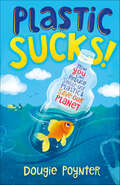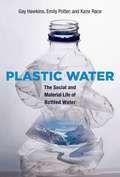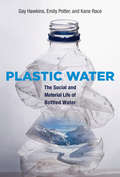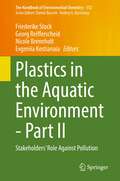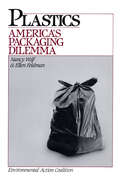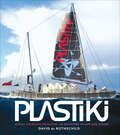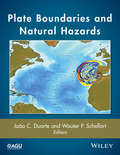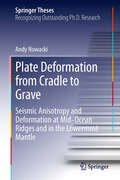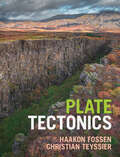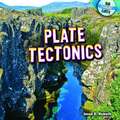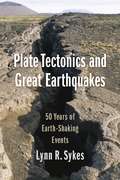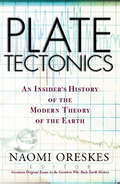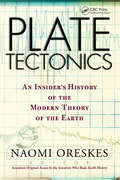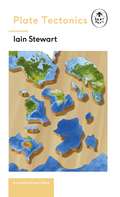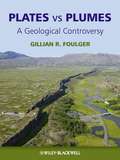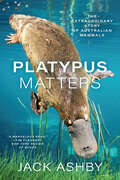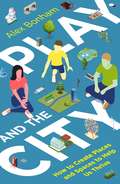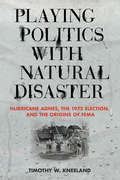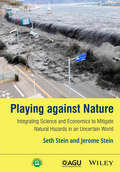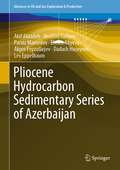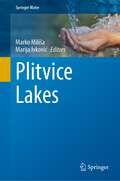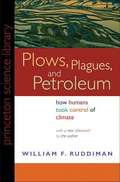- Table View
- List View
Plastic Sucks!: How You Can Reduce Single-Use Plastic & Save Our Planet
by Dougie PoynterHow can YOU help save our planet? This awesome and inspiring guide, written by musician and environmental activist Dougie Poynter, will tell you how to get involved in the mission to cut out single-use plastic.Plastic is everywhere and it sucks. It fills up our oceans, endangers our wildlife and never goes away. So it's time to take action, find ways to cut down our plastic use, and help protect our environment. Together we can make a difference!From the history of plastic to the effects of plastic on our planet to the innovations in plastic clean up and alternative materials, this book breaks down the plastic problem into easy digestible chapters (including "What's Going On", "Innovations in Cleanup," and "How to Create Change") that are packed with illustrations. And this isn't just a history of what's gone wrong with our environment; it's a handbook on how to change the world for better, empowering you to make everyday choices that help solve the plastic problem once and for all. Plastic Sucks! How YOU Can Reduce Single-Use Plastic and Save Our Planet shows us how we can all make small changes and become champions for our planet.
Plastic Water
by Kane Race Emily Potter Gay HawkinsHow did branded bottles of water insinuate themselves into our daily lives? Why did water become an economic good -- no longer a common resource but a commercial product, in industry parlance a "fast moving consumer good," or FMCG? Plastic Water examines the processes behind this transformation. It goes beyond the usual political and environmental critiques of bottled water to investigate its multiplicity, examining a bottle of water's simultaneous existence as, among other things, a product, personal health resource, object of boycotts, and part of accumulating waste matter. Throughout, the book focuses on the ontological dimensions of drinking bottled water -- the ways in which this habit enacts new relations and meanings that may interfere with other drinking water practices.The book considers the assemblage and emergence of a mass market for water, from the invention of the polyethylene terephthalate (PET) bottle in 1973 to the development of "hydration science" that accompanied the rise of jogging in the United States. It looks at what bottles do in the world, tracing drinking and disposal practices in three Asian cities with unreliable access to safe water: Bangkok, Chennai, and Hanoi. And it considers the possibility of ethical drinking, examining campaigns to "say no" to the bottle and promote the consumption of tap water in Canada, the United States, and Australia.
Plastic Water: The Social and Material Life of Bottled Water (The\mit Press Ser.)
by Kane Race Emily Potter Gay HawkinsHow and why branded bottles of water have insinuated themselves into our daily lives, and what the implications are for safe urban water supplies.How did branded bottles of water insinuate themselves into our daily lives? Why did water become an economic good—no longer a common resource but a commercial product, in industry parlance a “fast moving consumer good,” or FMCG? Plastic Water examines the processes behind this transformation. It goes beyond the usual political and environmental critiques of bottled water to investigate its multiplicity, examining a bottle of water's simultaneous existence as, among other things, a product, personal health resource, object of boycotts, and part of accumulating waste matter. Throughout, the book focuses on the ontological dimensions of drinking bottled water—the ways in which this habit enacts new relations and meanings that may interfere with other drinking water practices.The book considers the assemblage and emergence of a mass market for water, from the invention of the polyethylene terephthalate (PET) bottle in 1973 to the development of “hydration science” that accompanied the rise of jogging in the United States. It looks at what bottles do in the world, tracing drinking and disposal practices in three Asian cities with unreliable access to safe water: Bangkok, Chennai, and Hanoi. And it considers the possibility of ethical drinking, examining campaigns to “say no” to the bottle and promote the consumption of tap water in Canada, the United States, and Australia.
Plastics in the Aquatic Environment - Part II: Stakeholders' Role Against Pollution (The Handbook of Environmental Chemistry #112)
by Georg Reifferscheid Friederike Stock Nicole Brennholt Evgeniia KostianaiaThis book reviews comprehensively the opportunities and responsibilities of science, society and politics to combat plastic pollution in marine and freshwaters. It provides insights on what information is needed, and from whom, and it outlines policies proposed by various institutions including OSPAR, HELCOM and the European Union. Plastic waste has become a global threat to the aquatic environment that does not stop at country borders. Meanwhile, there are many efforts in science, industry, commerce and governments to tackle the problem worldwide. School education, NGO public actions, voluntary trade reduction measures, governmental management options and governmental regulatory actions are part of the portfolio of efforts to deal with the problem. Together with the companion volume Plastics in the Aquatic Environment - Part I: Current Status and Challenges, it provides scientists, policymakers and environmental managers with essential reference information on how this problem is being solved, what challenges and barriers are expected and how they can be overcome.
Plastics: America's Packaging Dilemma
by Ellen Feldman Nancy WolfPlastics explains what plastics are, how they are made, how they are used, and the problems and opportunities they bring.
Plastiki
by David de Rothschild&“A modern-day spin on Thor Heyerdahl&’s famous Kon-Tiki exploration . . . documents the 8,000-mile journey in all its hare-brained idealism.&” —The Atlantic Explorer, global green leader, and eco-TV host David de Rothschild recounts the extraordinary journey of the Plastiki, an innovative and mostly untested sixty-foot catamaran that floats on 12,500 reclaimed plastic bottles. It was a voyage that took de Rothschild and a five-person crew 10,000 miles from the US to Australia, sailing through rarely traveled, dangerous waters, risking their lives to call attention to our fragile oceans. Their exploration included urgent study of ocean pollution, island nations threatened by rising seas, damaged coral reefs, and the acidifying ocean itself—and their discoveries are a call to action. Packed with exciting narrative, images, maps, journal entries, plans, and sketches, this is the only firsthand account of what may be the most important adventure of our time. &“Complete with stories of the inspirations for the project, as well as memories of the construction of the boat, and of course, the journey itself, Plastiki is the definitive tome about a project that captured imaginations across the globe.&” —CNET
Plate Boundaries and Natural Hazards
by Joao C. Duarte Wouter P. SchellartThe beginning of the new millennium has been particularly devastating in terms of natural disasters associated with tectonic plate boundaries, such as earthquakes in Sumatra, Chile, Japan, Tahiti, and Nepal; the Indian Ocean and the Pacific Ocean tsunamis; and volcanoes in Indonesia, Chile, Iceland that have produced large quantities of ash causing major disruption to aviation. In total, half a million people were killed by such natural disasters. These recurring events have increased our awareness of the destructive power of natural hazards and the major risks associated with them. While we have come a long way in the search for understanding such natural phenomena, and although our knowledge of Earth dynamics and plate tectonics has improved enormously, there are still fundamental uncertainties in our understanding of natural hazards. Increased understanding is crucial to improve our capacity for hazard prediction and mitigation. Volume highlights include: Main concepts associated with tectonic plate boundaries Novel studies on boundary-related natural hazards Fundamental concepts that improve hazard prediction and mitigation Plate Boundaries and Natural Hazards will be a valuable resource for scientists and students in the fields of geophysics, geochemistry, plate tectonics, natural hazards, and climate science.
Plate Deformation from Cradle to Grave
by Andy NowackiThe Earth's rocky mantle convects to lose heat, which comes from the liquid iron core below. The mantle's interfaces - the core-mantle boundary, and the lithosphere - may hold the key to understanding mantle motion because of the seismic anisotropy present in these parts of the Earth. In this thesis, Andy Nowacki presents a precise but comprehensive review of the current state of the art in studying flow with anisotropy, mineral physics and geodynamics. New measurements of shear wave anisotropy in the lowermost mantle and at mid-ocean ridges are used to constrain mechanisms of creep and melt extraction in the mantle. A model of global flow is used to predict anisotropy in the deep Earth, and novel methods to forward model shear wave splitting are described. Future studies of mantle flow must incorporate the understanding gained in this thesis. The thesis contains a substantive introduction to the structure of the Earth, seismic anisotropy in general and in the core-mantle boundary region, and mid-ocean ridge processes. It also describes novel methods for forward modelling and interpreting shear wave splitting data. Three chapters present timely research into dynamics at divergent plate boundaries and at the core-mantle boundary.
Plate Tectonics
by Haakon Fossen Christian TeyssierThis advanced undergraduate textbook provides a thoroughly modern overview of plate tectonics and is the perfect resource for a capstone geology course. It presents plate tectonics as a multifaceted, interdisciplinary theory that unites many different geological observations and processes into a harmonious model so that readers grasp how the outer part of our planet works in relation to the deep interior. Supported by clear prose, helpful analogies, and stunning colour imagery, readers will gain an in-depth understanding of how and why plates interact to produce different topography, rock assemblages and deformation features along plate boundaries. Written by an author pairing renowned for their research, teaching, and textbook writing experience, this text covers necessary ground for a single-semester course without overwhelming readers and offers a truly accessible introduction to quantitative topics. Student-friendly features chart clear paths through every chapter and a rich suite of online resources bring plate tectonics to life.
Plate Tectonics
by Jason D. NemethAround 225 million years ago, Earth was home to the supercontinent Pangaea and the massive sea Panthalassa. In fact, Earth's land and water existed in several configurations before today's familiar continents and oceans formed. Readers of this book will get an accessible introduction to plate tectonics. This key scientific theory explains why Earth's landmasses have changed over time. The theory posits that the planet's crust is broken up into plates that are constantly, if slowly, on the move. The book also examines the impact of plate tectonics on volcanoes, earthquakes, and the formation of mountains and rift valleys.
Plate Tectonics and Great Earthquakes: 50 Years of Earth-Shaking Events
by Lynn R. SykesThe theory of plate tectonics transformed earth science. The hypothesis that the earth’s outermost layers consist of mostly rigid plates that move over an inner surface helped describe the growth of new seafloor, confirm continental drift, and explain why earthquakes and volcanoes occur in some places and not others. Lynn R. Sykes played a key role in the birth of plate tectonics, conducting revelatory research on earthquakes. In this book, he gives an invaluable insider’s perspective on the theory’s development and its implications.Sykes combines lucid explanation of how plate tectonics revolutionized geology with unparalleled personal reflections. He entered the field when it was on the cusp of radical discoveries. Studying the distribution and mechanisms of earthquakes, Sykes pioneered the identification of seismic gaps—regions that have not ruptured in great earthquakes for a long time—and methods to estimate the possibility of quake recurrence. He recounts the various phases of his career, including his antinuclear activism, and the stories of colleagues around the world who took part in changing the paradigm. Sykes delves into the controversies over earthquake prediction and their importance, especially in the wake of the giant 2011 Japanese earthquake and the accompanying Fukushima disaster. He highlights geology’s lessons for nuclear safety, explaining why historic earthquake patterns are crucial to understanding the risks to power plants. Plate Tectonics and Great Earthquakes is the story of a scientist witnessing a revolution and playing an essential role in making it.
Plate Tectonics: An Insider's History of the Modern Theory of the Earth
by Naomi OreskesCan anyone today imagine the earth without its puzzle-piece construction of plate tectonics? The very term, "plate tectonics," coined only thirty-five years ago, is now part of the vernacular, part of everyone's understanding of the way the earth works. The theory, research, data collection, and analysis that came together in the late 1960’s to constitute plate tectonics is one of the great scientific breakthroughs of the 20th century. Scholarly books have been written about tectonics, but none by the key scientists-players themselves. In Plate Tectonics, editor Naomi Oreskes has assembled those scientists who played crucial roles in developing the theory to tell - for the first time, and in their own words - the stories of their involvement in the extraordinary confrimation of the theory. The book opens with an overview of the history of plate tectonics, including in-context definitions of the key terms that are discussed throughout the book. Oreskes explains how the forerunners of the theory, Wegener and du Toit, raised questions that were finally answered thirty years later, and how scientists working at the key academic institutions - Cambridge and Princeton Universities, Columbia University's Lamont Doherty Geological Observatory, and the University of California-San Diego's Scripps Institution of Oceanography - competed and collaborated until the theory coalesced.
Plate Tectonics: An Insider's History of the Modern Theory of the Earth (Frontiers in Physics)
by Naomi Oreskes<p>Can anyone today imagine the earth without its puzzle-piece construction of plate tectonics? The very term, "plate tectonics," coined only thirty-five years ago, is now part of the vernacular, part of everyone's understanding of the way the earth works. <p>The theory, research, data collection, and analysis that came together in the late 1960's to constitute plate tectonics is one of the great scientific breakthroughs of the 20th century. Scholarly books have been written about tectonics, but none by the key scientists-players themselves. In Plate Tectonics, editor Naomi Oreskes has assembled those scientists who played crucial roles in developing the theory to tell - for the first time, and in their own words - the stories of their involvement in the extraordinary confrimation of the theory. <p>The book opens with an overview of the history of plate tectonics, including in-context definitions of the key terms that are discussed throughout the book. Oreskes explains how the forerunners of the theory, Wegener and du Toit, raised questions that were finally answered thirty years later, and how scientists working at the key academic institutions - Cambridge and Princeton Universities, Columbia University's Lamont Doherty Geological Observatory, and the University of California-San Diego's Scripps Institution of Oceanography – competed and collaborated until the theory coalesced.
Plate Tectonics: Continental Drift and Mountain Building (Springer Textbooks in Earth Sciences, Geography and Environment)
by Martin Meschede Ronald C. Blakey Wolfgang FrischThis textbook explains how mountains are formed and why there are old and young mountains. It provides a reconstruction of the Earths paleogeography and shows why the shapes of South America and Africa fit so well together. Furthermore, it explains why the Pacific is surrounded by a ring of volcanos and earthquake-prone areas while the edges of the Atlantic are relatively peaceful.This thoroughly revised textbook edition addresses all these questions and more through the presentation and explanation of the geodynamic processes upon which the theory of continental drift is based and which have led to the concept of plate tectonics. It is a source of information for students of geology, geophysics, geography, geosciences in general, general natural sciences, as well as professionals, and interested layman.
Plate Tectonics: Discover how our planet works from the inside out (The Ladybird Expert Series #4)
by Iain StewartHow do plate tectonics work? Learn from the experts in the ALL-NEW LADYBIRD EXPERT SERIESDiscover in this accessible and authoritative introduction the fundamental theory of how our dynamic planet works.You'll learn about the make up of the Earth in the past and the present, from monsoon-like currents in our planet's radioactive interior to magnetic force lines and what the planet would look like without water.You will learn about:- Our planet as an active living system- The planetary force field- Fault lines that cross continents- How plates tectonics protects life on Earth- And much more . . .Written by the celebrated geologist, academic and popular science presenter Iain Stewart, Plate Tectonics explores the Earth as a planetary machine and investigates the people and ideas that changed the way we look at the world.Learn about other topics in the Ladybird Experts series including Gravity, Quantum Physics, Climate Change and Evolution.Written by the leading lights and most outstanding communicators in their fields, the Ladybird Expert books provide clear, accessible and authoritative introductions to subjects drawn from science, history and culture.For an adult readership, the Ladybird Expert series is produced in the same iconic small hardback format pioneered by the original Ladybirds. Each beautifully illustrated book features the first new illustrations produced in the original Ladybird style for nearly forty years.
Plates vs Plumes
by Gillian R. FoulgerSince the advent of the mantle plume hypothesis in 1971, scientists have been faced with the problem that its predictions are not confirmed by observation. For thirty years, the usual reaction has been to adapt the hypothesis in numerous ways. As a result, the multitude of current plume variants now amounts to an unfalsifiable hypothesis.In the early 21st century demand became relentless for a theory that can explain melting anomalies in a way that fits the observations naturally and is forward-predictive. From this the Plate hypothesis emerged-the exact inverse of the Plume hypothesis. The Plate hypothesis attributes melting anomalies to shallow effects directly related to plate tectonics. It rejects the hypothesis that surface volcanism is driven by convection in the deep mantle.Earth Science is currently in the midst of the kind of paradigm-challenging debate that occurs only rarely in any field. This volume comprises its first handbook. It reviews the Plate and Plume hypotheses, including a clear statement of the former. Thereafter it follows an observational approach, drawing widely from many volcanic regions in chapters on vertical motions of Earth's crust, magma volumes, time-progressions of volcanism, seismic imaging, mantle temperature and geochemistry.This text:Deals with a paradigm shift in Earth Science - some say the most important since plate tectonicsIs analogous to Wegener's The Origin of Continents and OceansIs written to be accessible to scientists and students from all specialitiesThis book is indispensable to Earth scientists from all specialties who are interested in this new subject. It is suitable as a reference work for those teaching relevant classes, and an ideal text for advanced undergraduates and graduate students studying plate tectonics and related topics.Visit Gillian's own website at http://www.mantleplumes.org
Platypus Matters: The Extraordinary Story of Australian Mammals
by Jack AshbyScientifically informed and funny, a firsthand account of Australia’s wonderfully unique mammals—and how our perceptions impact their future. Think of a platypus: They lay eggs (that hatch into so-called platypups), produce milk without nipples and venom without fangs, and can detect electricity. Or a wombat: Their teeth never stop growing, they poop cubes, and they defend themselves with reinforced rears. And what about antechinuses—tiny marsupial carnivores whose males don’t see their first birthday, as their frenzied sex lives take so much energy that their immune systems fail? Platypuses, possums, wombats, echidnas, devils, kangaroos, quolls, dibblers, dunnarts, kowaris: Australia has some truly astonishing mammals, with incredible, unfamiliar features. But how does the world regard these creatures? And what does that mean for their conservation? In Platypus Matters, naturalist Jack Ashby shares his love for these often-misunderstood animals. Informed by his own experiences meeting living marsupials and egg-laying mammals during fieldwork in Tasmania and mainland Australia, as well as his work with thousands of zoological specimens collected for museums over the last two-hundred-plus years, Ashby’s tale not only explains historical mysteries and debunks myths (especially about the platypus), but also reveals the toll these myths can take. Ashby makes clear that calling these animals “weird” or “primitive”—or incorrectly implying that Australia is an “evolutionary backwater,” a perception that can be traced back to the country’s colonial history—has undermined conservation: Australia now has the worst mammal extinction rate of any place on Earth. Important, timely, and written with humor and wisdom by a scientist and self-described platypus nerd, this celebration of Australian wildlife will open eyes and change minds about how we contemplate and interact with the natural world—everywhere.
Play and the City: How to Create Places and Spaces To Help Us Thrive
by Alex BonhamPlay is essential, for children but also adults. It's how we relax and revitalise ourselves, build and maintain friendships, try new things, learn and innovate.Cities have always been sites of play, bringing people together and pushing the boundaries of what is humanly possible. And now we need our cities to encourage and facilitate play of all kinds more than ever. If we want a world for our children to play in, we need to have a go at doing things differently. A city that is enjoyable to live in - that provides welcoming spaces, plentiful resources, and an attitude of 'yes, you can' - is a playful city. A city that is good for eight-year-olds as well as eighty-year-olds is a city that's good for all of us. By looking at how different cities across space and time have sought to encourage and facilitate play, Bonham shows us how to conceptualise our own contemporary city as a game, and encourages us to become participants rather than spectators.Play the city! Get involved, make a difference and help to bring your city back to life. There is help here to identify opportunities, build a team of friends and allies, take part - and win! It's time to make your move.
Play and the City: How to Create Places and Spaces To Help Us Thrive
by Alex BonhamPlay is essential, for children but also adults. It's how we relax and revitalise ourselves, build and maintain friendships, try new things, learn and innovate.Cities have always been sites of play, bringing people together and pushing the boundaries of what is humanly possible. And now we need our cities to encourage and facilitate play of all kinds more than ever. If we want a world for our children to play in, we need to have a go at doing things differently. A city that is enjoyable to live in - that provides welcoming spaces, plentiful resources, and an attitude of 'yes, you can' - is a playful city. A city that is good for eight-year-olds as well as eighty-year-olds is a city that's good for all of us. By looking at how different cities across space and time have sought to encourage and facilitate play, Bonham shows us how to conceptualise our own contemporary city as a game, and encourages us to become participants rather than spectators.Play the city! Get involved, make a difference and help to bring your city back to life. There is help here to identify opportunities, build a team of friends and allies, take part - and win! It's time to make your move.
Playing Politics with Natural Disaster: Hurricane Agnes, the 1972 Election, and the Origins of FEMA
by Timothy W. KneelandHurricane Agnes struck the United States in June of 1972, just months before a pivotal election and at the dawn of the deindustrialization period across the Northeast. The response by local, state, and national officials had long-term consequences for all Americans. President Richard Nixon used the tragedy for political gain by delivering a generous relief package to the key states of New York and Pennsylvania in a bid to win over voters. After his landslide reelection in 1972, Nixon cut benefits for disaster victims and then passed legislation to push responsibility for disaster preparation and mitigation onto states and localities. The impact led to the rise of emergency management and inspired the development of the Federal Emergency Management Agency (FEMA).With a particular focus on events in New York and Pennsylvania, Timothy W. Kneeland narrates how local, state, and federal authorities responded to the immediate crisis of Hurricane Agnes and managed the long-term recovery. The impact of Agnes was horrific, as the storm left 122 people dead, forced tens of thousands into homelessness, and caused billions of dollars in damage from Florida to New York. In its aftermath, local officials and leaders directed disaster relief funds to rebuild their shattered cities and reshaped future disaster policies.Playing Politics with Natural Disaster explains how the political decisions by local, state, and federal officials shaped state and national disaster policy and continues to influence emergency preparedness and response to this day.
Playing against Nature: Integrating Science and Economics to Mitigate Natural Hazards in an Uncertain World (Wiley Works)
by Seth Stein Jerome SteinDefending society against natural hazards is a high-stakes game of chance against nature, involving tough decisions. How should a developing nation allocate its budget between building schools for towns without ones or making existing schools earthquake-resistant? Does it make more sense to build levees to protect against floods, or to prevent development in the areas at risk? Would more lives be saved by making hospitals earthquake-resistant, or using the funds for patient care? What should scientists tell the public when – as occurred in L’Aquila, Italy and Mammoth Lakes, California – there is a real but small risk of an upcoming earthquake or volcanic eruption? Recent hurricanes, earthquakes, and tsunamis show that society often handles such choices poorly. Sometimes nature surprises us, when an earthquake, hurricane, or flood is bigger or has greater effects than expected from detailed hazard assessments. In other cases, nature outsmarts us, doing great damage despite expensive mitigation measures or causing us to divert limited resources to mitigate hazards that are overestimated. Much of the problem comes from the fact that formulating effective natural hazard policy involves combining science, economics, and risk analysis to analyze a problem and explore the costs and benefits of different options, in situations where the future is very uncertain. Because mitigation policies are typically chosen without such analysis, the results are often disappointing. This book uses general principles and case studies to explore how we can do better by taking an integrated view of natural hazards issues, rather than treating the relevant geoscience, engineering, economics, and policy formulation separately. Thought-provoking questions at the end of each chapter invite readers to confront the complex issues involved. Readership: Instructors, researchers, practitioners, and students interested in geoscience, engineering, economics, or policy issues relevant to natural hazards. Suitable for upper-level undergraduate or graduate courses. Additional resources can be found at: http://www.wiley.com/go/Stein/Playingagainstnature
Plight of the Pelican: How Science Saved a Species (Books for a Better Earth)
by Jessica StremerA richly illustrated nonfiction picture book celebrating how scientists and activists can work together to create change and protect wildlife, making the world safer for creatures both big and small.How do you save a species? Start at the edges of the food chain.In the 1950s, the brown pelican went from thriving to barely surviving. The culprit was DDT: a harmful pesticide that seeped into soil, spread in the water, festered in small fish, and ultimately caused the pelican population to plummet. Scientists sounded the alarm, but faced pushback from farmers who relied on DDT to control pesky pests. It required many voices joining together, demanding change, before the government took action. Thanks to these efforts, we now have the EPA and the Endangered Species Act, which continue to protect wildlife threatened by climate change.This thrilling and inspirational nonfiction picture book introduces young readers to bioaccumulation, endangered species, and one of the biggest grassroots movements of our time. It connects the success of the pelican&’s regrowth with conservation efforts in place today, such as pollinator gardens, wildlife corridors, and much more.Sweeping illustrations depict the brown pelican&’s journey from near extinction to a robust, populous species. Back matter includes more details on the EPA, a glossary, and an index.
Pliocene Hydrocarbon Sedimentary Series of Azerbaijan (Advances in Oil and Gas Exploration & Production)
by Lev Eppelbaum Akif Alizadeh Ibrahim Guliyev Parviz Mamedov Elmira Aliyeva Akper Feyzullayev Dadash HuseynovThis book demonstrates different stages of hydrocarbon deposit localization in a tectonically complex region—the South Caspian Mega-Basin (SCMB). Each of the stages: tectonics, sedimentation, lithology, structural analysis, and geophysical method application is described in detail and accompanied by numerous color (major) and black-white (minor) illustrations. The main benefit of this book is that the Azerbaijan hydrocarbon province has been investigated for more than 150 years, resulting in a very comprehensive archive of geological information. This book is intended not only for students of various degrees, but also for professional geologists studying principles of hydrocarbon accumulations under difficult geological environments.
Plitvice Lakes (Springer Water)
by Marko Miliša Marija IvkovićAfter providing a historical overview, this book highlights the current state of knowledge, gaps in our knowledge, recent findings and future prospects with regard to the biological, chemical, geological, and geographical specificities of the Plitvice lakes in Croatia. The Plitvice lakes are a unique environment and home to tufa – a type of calcium carbonate deposit that provides a substrate for living organisms. Its formation process has resulted in a vastly diverse environment of lakes, streams and riparian habitats. The Plitvice lakes have, therefore, historically been both an inspiration and a challenge for scientists, nature enthusiasts, artists, etc. Today, the lakes continue to offer an in-situ laboratory for new discoveries in all aspects of freshwater science.As in most habitats, global changes have become an important issue. Since the Plitvice lakes have remained largely untouched by direct human impacts and have a long historical tradition in research, they represent an ideal subject for assessing the effects of global changes in a temperate freshwater system. This book provides an ecological overview of the biogeochemical processes at work in a unique and virtually pristine European freshwater tufa-forming environment.
Plows, Plagues, and Petroleum: How Humans Took Control of Climate
by William F. RuddimanThe impact on climate from 200 years of industrial development is an everyday fact of life, but did humankind's active involvement in climate change really begin with the industrial revolution, as commonly believed? Plows, Plagues, and Petroleum has sparked lively scientific debate since it was first published--arguing that humans have actually been changing the climate for some 8,000 years--as a result of the earlier discovery of agriculture. The "Ruddiman Hypothesis" will spark intense debate. We learn that the impact of farming on greenhouse-gas levels, thousands of years before the industrial revolution, kept our planet notably warmer than if natural climate cycles had prevailed--quite possibly forestalling a new ice age. Plows, Plagues, and Petroleum is the first book to trace the full historical sweep of human interaction with Earth's climate. Ruddiman takes us through three broad stages of human history: when nature was in control; when humans began to take control, discovering agriculture and affecting climate through carbon dioxide and methane emissions; and, finally, the more recent human impact on climate change. Along the way he raises the fascinating possibility that plagues, by depleting human populations, also affected reforestation and thus climate--as suggested by dips in greenhouse gases when major pandemics have occurred. While our massive usage of fossil fuels has certainly contributed to modern climate change, Ruddiman shows that industrial growth is only part of the picture. The book concludes by looking to the future and critiquing the impact of special interest money on the global warming debate. In a new afterword, Ruddiman explores the main challenges posed to his hypothesis, and shows how recent investigations and findings ultimately strengthen the book's original claims.
